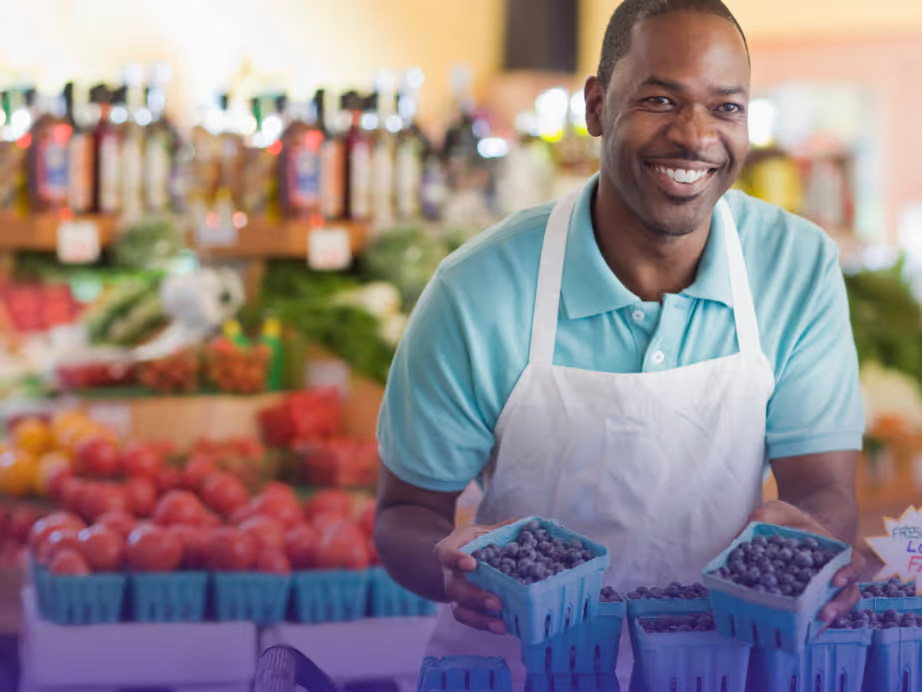The Evolution of On-Demand Grocery and Retail: Navigating the Shift Towards Consumer Convenience
%20(27).avif)

Introduction
In the dynamic landscape of consumer behavior, the retail and grocery industry is undergoing a transformative shift, marked by the rising popularity of on-demand services. Driven by the need for convenience and time-efficiency, today's consumers are reshaping the way we approach grocery and retail experiences. In this blog post, we will delve into current data and trends that underscore the increasing prominence of on-demand services, explore the factors driving this shift and discuss the implications for businesses in the sector.
1. The Rise of On-Demand Services: A Data-Driven Perspective
Let's start by examining the numbers that paint a vivid picture of the surge in on-demand grocery and retail services. According to a recent industry report by Statista, the on-demand grocery delivery market is projected to grow at an annual rate of 10% over the next five years. This growth, which excludes on-demand pickup, is attributed to a rise in consumer expectations for speed and convenience, increased smartphone penetration, and a growing preference for hassle-free shopping experiences.

2. Convenience as the Driving Force
Consumer expectations are evolving, and the demand for convenience has become a driving force behind the popularity of on-demand services. Time-starved individuals, balancing work, family, and social commitments, are seeking efficient and convenient solutions for their everyday needs.
A recent survey by PYMTS indicates that Convenience is driving grocery shopping choices for 8 in 10 consumers. 77% of consumers prioritize convenience as a key factor in their choice of grocery shopping method, with an increasing number of individuals valuing the time saved through on-demand services.

3. The Impact of Technology on Consumer Expectations
In the era of smartphones and instant connectivity, technology plays a pivotal role in shaping consumer expectations. Mobile apps and online platforms are becoming the preferred avenues for grocery and retail shopping, allowing users to order products with a few taps on their screens.
Studies published in 2020 in the US and 2021 in the EU reveal that more than seven in 10 consumers use mobile apps for grocery shopping, a significant uptick from just a few years ago. This emphasizes the need for businesses to invest in user-friendly, responsive apps that cater to the evolving preferences of their customer base.
4. Adapting Business Models to Meet Consumer Expectations
To remain competitive in today’s dynamic market, businesses must adapt their models to align with shifting consumer expectations. The success stories of on-demand grocery platforms such as Deliveroo Hop, highlight the importance and effectiveness of providing a seamless, convenient, and reliable service.
The landscape of convenience shopping is rapidly expanding beyond just home deliveries. The trend is increasingly moving towards on-demand grocery pickups, a sector poised for significant growth.
While grocery stores have traditionally emphasized weekly shopping with larger baskets, it's becoming essential to adapt and serve customers in various ways that cater to customer convenience. This shift ensures that customers not only find value in the brand but also remain actively engaged with it.
5. Future Trends and Strategic Considerations
As we look ahead, it is crucial for grocers and retailers to not only keep pace but to stay ahead of the curve in a rapidly evolving on-demand market. The trajectory of the industry points towards several key trends that are poised to redefine the landscape of grocery and retail services.
Personalized Shopping Experiences: In an era where data is king, leveraging customer data to offer personalized shopping experiences will become increasingly vital. Retailers that harness the power of AI and machine learning to analyze shopping habits and preferences can provide tailored product recommendations, creating a more engaging and satisfying shopping experience.
Sustainable Practices and Lowering Food Waste: Environmental consciousness is no longer just a niche concern but a mainstream expectation. Retailers who adopt sustainable practices, especially those aimed at reducing food waste, will not only contribute to a healthier planet but also resonate strongly with eco-aware consumers. This could include initiatives like optimized supply chains to reduce spoilage, offering imperfect produce at a discount, and using eco-friendly packaging.
Expansion Beyond Food Items and Larger Basket Sizes: As consumer behavior shifts, on-demand services are likely to see an expansion in product range. This includes offering non-food items and catering to larger basket sizes, meeting the needs of consumers seeking a one-stop shopping solution. The appeal of swiftly delivered, diverse product offerings, encompassing everything from groceries to household necessities, will be a major attraction for consumers.
Innovative Delivery Solutions: The future of on-demand grocery is not just in what is delivered but also in how it is delivered. Innovations in delivery methods, such as the use of drones, autonomous vehicles, and robotics, promise to make deliveries faster, more efficient, and more cost-effective. As these technologies mature, they could significantly reduce delivery times, offering near-instant gratification to consumers.
The Rise of Retailer Media Networks: An emerging trend in the grocery and retail sector is the development of Retailer Media Networks. These networks represent in-house advertising channels, whether in-store on digital screens, on the retailer's website, or within their apps. They not only create additional revenue streams for retailers but also enhance the shopping experience by promoting relevant products and offers. To ensure effectiveness and accuracy, it is essential to integrate these networks with live, real-time inventory and replenishment systems. By ensuring advertised products are readily available for purchase, live system integration effectively eliminates consumer frustration caused by encountering unavailable items. Successful deployment of these networks can result in a dual benefit: boosting revenue and enhancing customer satisfaction.
Adapting to these trends requires strategic vision and a willingness to innovate. Grocery retailers that proactively adopt and weave these evolving patterns into their business frameworks stand to excel in the competitive on-demand grocery and retail sector. The key to success hinges on understanding and anticipating consumer needs, investing in future-forward solutions, maintaining agility, and persistently evolving to deliver exceptional service and convenience to fuel long-term growth.
Conclusion
In conclusion, the surge in on-demand grocery and retail services is a testament to the changing preferences and expectations of today's consumers. By analyzing current data and trends, we can discern a clear trajectory towards greater convenience and efficiency in shopping experiences.
Businesses that recognize and adapt to this shift stand to benefit from the growing need for on-demand services. This requires a commitment to transformative action and the implementation of cutting-edge solutions such as: intuitive mobile applications, innovative delivery solutions, live, real-time inventory management, rapid and agile warehouse operations, meticulous replenishment forecasting tools, and eco-conscious practices. The key to success in this realm is rooted in not just fulfilling but surpassing consumer expectations.
As we navigate this dynamic landscape, it is evident that the on-demand revolution is here to stay, reshaping the future of grocery and retail in a way that prioritizes the ultimate currency – consumer convenience.
Are you ready to embark on this transformative journey? Contact OrderGrid today to discover how we are empowering grocers of all sizes with advanced, on-demand solutions. Our approach is designed to attract and retain customers by enriching their shopping journey and delivering value at every touchpoint. This approach is not only cost-efficient but also strategically aimed at significantly enhancing your profitability.
Embrace the future of grocery shopping with OrderGrid – a solution that boasts efficiency, cost-effectiveness, and is in tune with modern consumer demands. Don't just keep up with the trends; leverage them to elevate your business. Connect with OrderGrid today and see how we can revolutionize your grocery operations in this dynamic market.
Related articles




%20(50).avif)
%20(49).avif)


